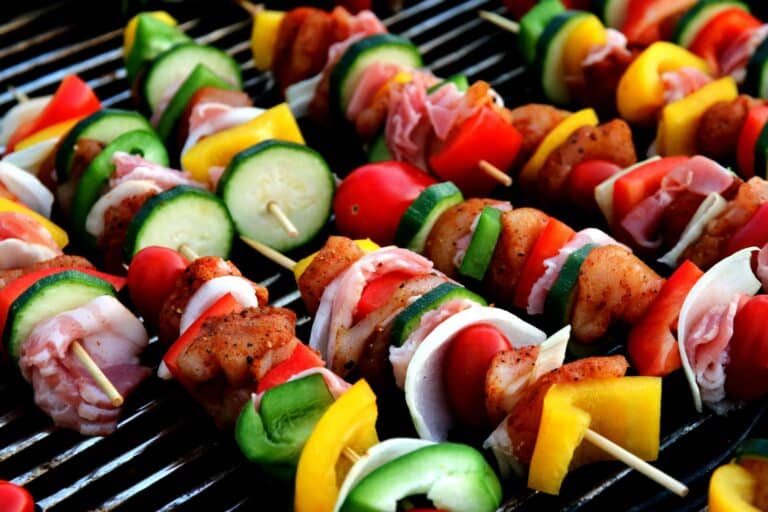Turkey is a transcontinental nation bridging Europe and Asia, so it’s no surprise it has an eclectic culinary heritage. Historically, the country is home to the former Ottoman Empire and blends Mediterranean, Middle Eastern, Central Asian, and Balkan cultures. In this sense, Turkish cuisine is a tapestry of flavors and traditions.
Whether you’re planning an Istanbul food tour or trying to expand your palate, Turkish food combines familiar and exotic tastes. Here at Remitly, we’re proud to celebrate the diverse cuisines of our global customers in this series. Join us as we explore Turkish gastronomy, where every dish tells a story.
Most popular Turkish dishes
1. Kebab
Kebab is Turkey’s national dish, consisting of grilled meat served in various forms. In Turkish, “döner” means “turning,” so the meat rotates over the grill. Thin slices of crispy meat are then shaved off, placed in pita bread, and served with condiments. For more facts about Turkey’s national dish, you can read the Remitly article here.
For many, this is Turkish fast food at its finest. Popular variations include:
- Döner kebab: meat cooked on a vertical rotisserie and shaved off into strips.
- Adana kebab: minced meat mixed with spices and grilled on skewers.
- Shish kebab: marinated grilled meats on skewers.
- Iskender kebap: thin slices of kebab meat on pita bread with hot tomato sauce, yogurt, and melted butter.
- Chicken tikka kebab: based on the Indian delicacy.
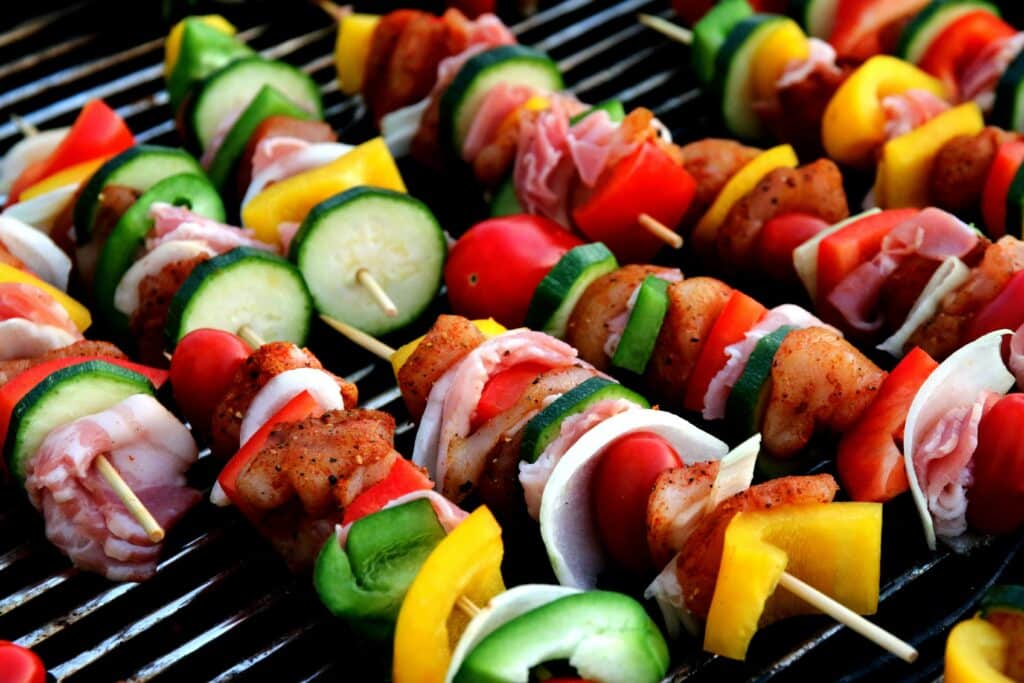
2. Köfte
Köfte are meatballs or patties of ground beef or lamb mixed with herbs and spices. The origin of the name köfte is the Persian verb “kuftan,” meaning “to pound” or “to ground.” Variations include:
- Sulu köfte: stew-like, with tomato sauce.
- Izgara köfte: grilled and served with rice or bulgur.
- Çiğ köfte: Raw meatball” made with finely minced beef or lamb, bulgur, spices, lemon juice, and sometimes pomegranate molasses for sweetness.
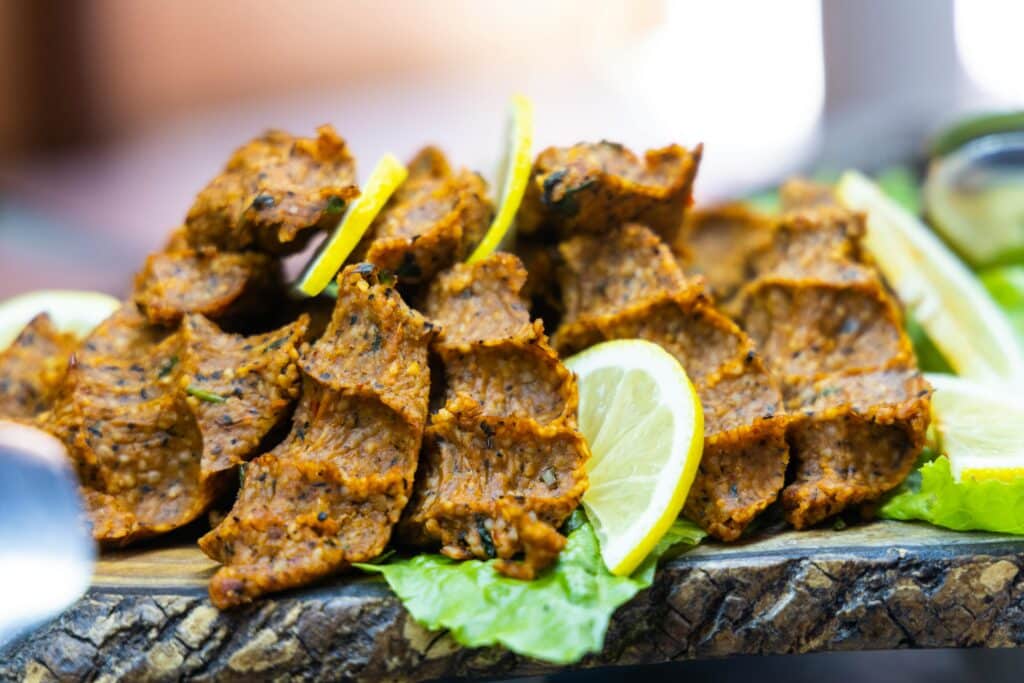
3. Manti
A famous Turkish dish, manti are small dumplings filled with spicy lamb or beef. Dating back to the Silk Road, the word manti is from “mantou” in Chinese, which means “steamed bun” or “dumpling.” Yogurt and butter sauces, as well as garnishes like mint or parsley, can accompany these. Types of manti include:
- Kayseri manti: smaller and served in a broth.
- Armenian manti: submerged in tomato sauce.
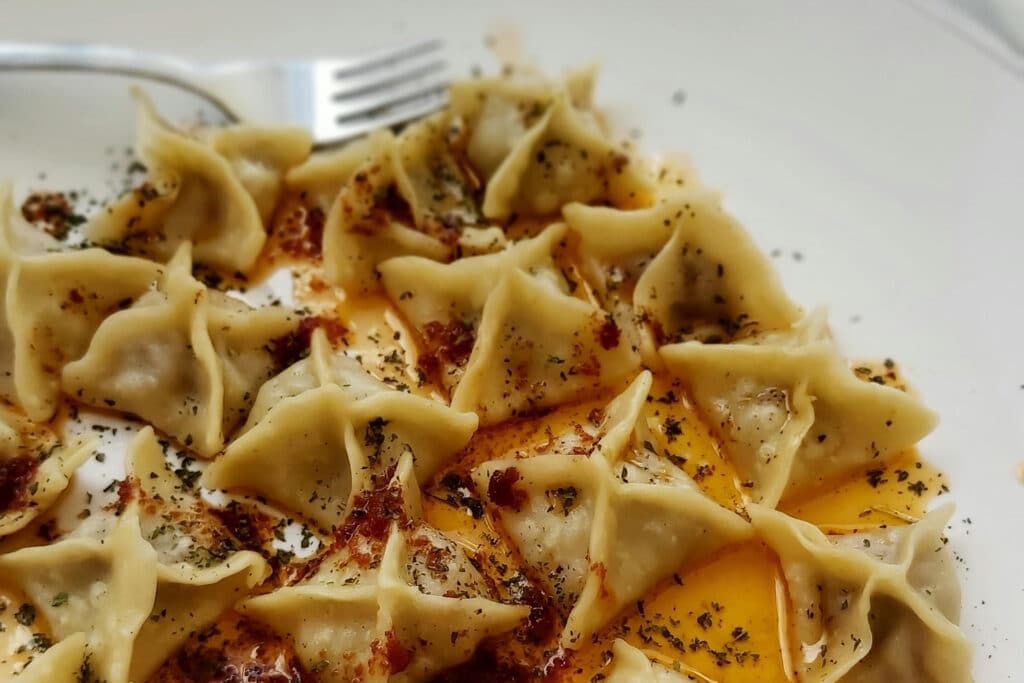
4. Börek
As a snack, appetizer, or meal, börek is a renowned pastry containing filo dough and savory ingredients. The name is the Turkish word for “to twist” or “to roll,” reflecting how you can prepare this dish by forming the dough in different shapes. Melted butter on every layer is essential before baking to a golden brown. Types of börek include:
Cheese (Peynirli börek)
- Meat (Kıymalı börek)
- Spinach (Ispanaklı börek)
- Potato (Patatesli börek)

5. Gözleme
Gözleme is a variation of Turkish flatbread that’s cooked on a griddle. It’s like a calzone, with folded-over dough filled with juicy morsels. The name comes from the Turkish word “göz,” meaning “compartment” or “pocket.” Common preparations include:
- Cheese (Peynirli gözleme)
- Spinach (Ispanaklı gözleme)
- Potato (Patatesli gözleme)
- Minced Meat (Kıymalı gözleme)

6. Pide
When you crave pizza in Turkey, try the country’s signature flatbread dish, pide. Known as Turkish pizza, the origin comes from the Greek word “pita,” meaning “flatbread” or “pie.” Today, it has been adapted from Greece as a Turkish dish celebrating its Mediterranean heritage. With the dough formed like a boat, cheeses, meats, vegetables, and sometimes an egg go on before entering the oven.
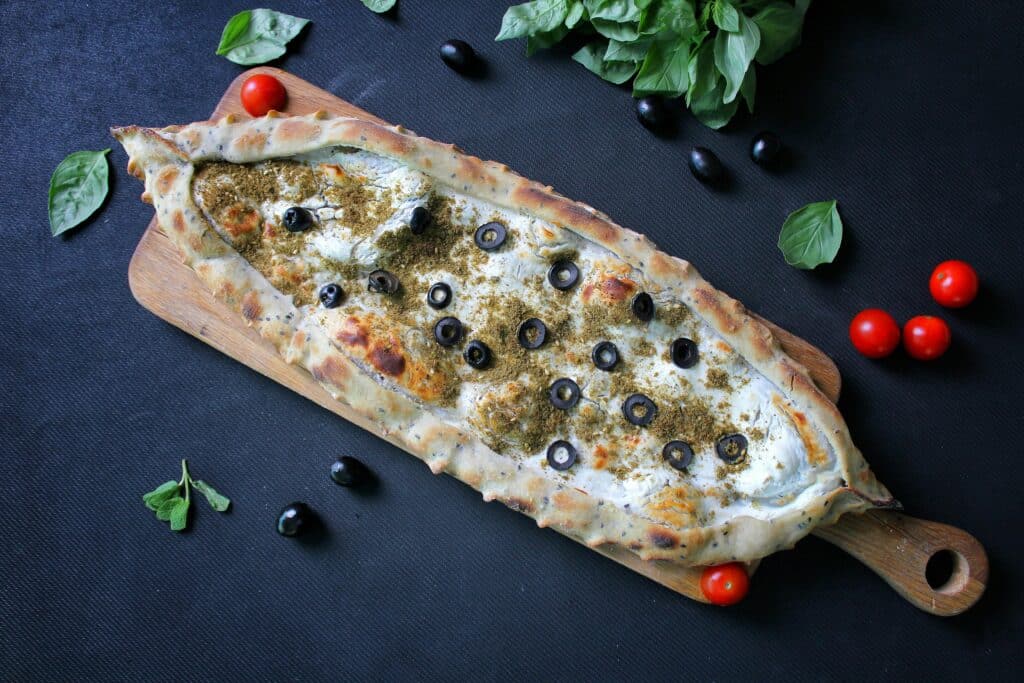
7. Dolma
Dolmas generally consist of vegetables, grape leaves, or fruits stuffed with seasoned filling, such as rice, ground meat, or both. The name comes from the Turkish verb “dolma,” meaning “to fill” or “to stuff.” Special occasions, family gatherings, and festive celebrations often feature dolmas, and they can be served hot or cold. Due to its adaptability, it’s one of Turkey’s most popular vegetable dishes.

8. Lahmacun
Competing against pide is lahmacun, another variation of Turkish pizza. The etymology of this dish comes from the Arabic phrase “lahm b’ajin,” meaning meat with dough. Foodies can find this street food and popular family dish across Turkey. Known for its thin crust and tender fillings, the most common way to enjoy lahmacun is to roll it up.
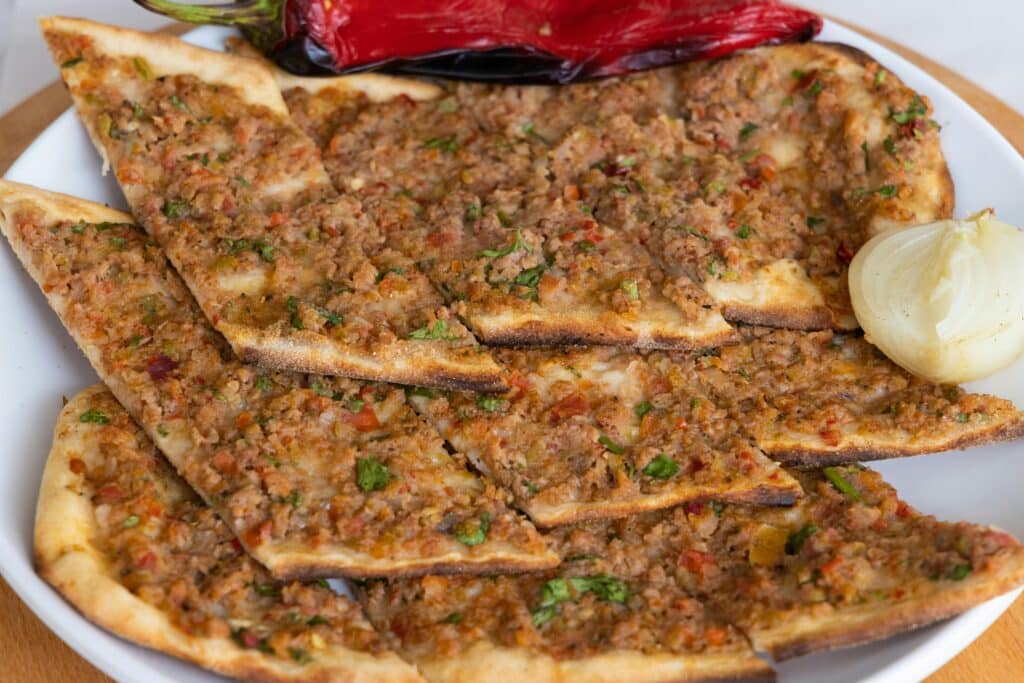
9. Baklava
Beloved in Turkey and worldwide, baklava is a sweet pastry made from multiple layers of thin filo dough. After forming the base, Turkish bakers add chopped nuts, usually pistachios or almonds. The layers then receive generous amounts of butter for a flaky, crispy texture. The final step is adding sweetening like syrups, honey, or rosewater, a sweet-dish signature of Turkey.
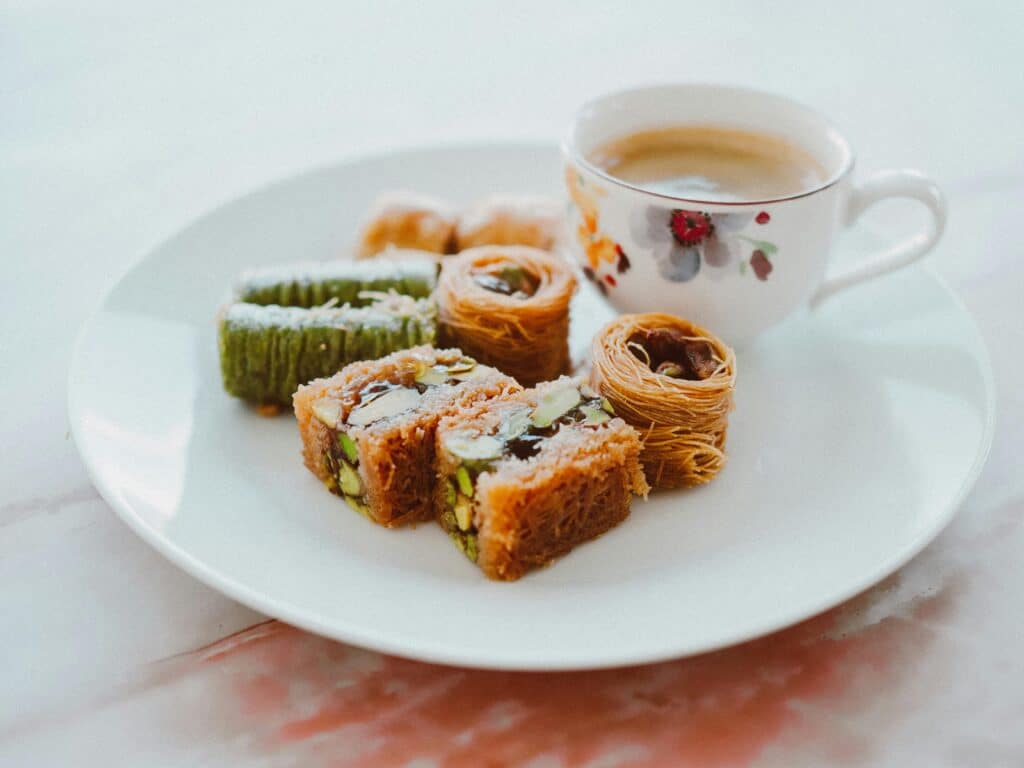
10. Menemen
Scrambled eggs, tomatoes, red peppers, and onion cooked in olive oil make menemen, the country’s most famous Turkish breakfast dish. The name derives from the town of Menemen in the Izmir Province of Turkey. Savory and slightly tangy, Turks adore this dish not only for its robust flavor but also for simple, single-dish preparation.
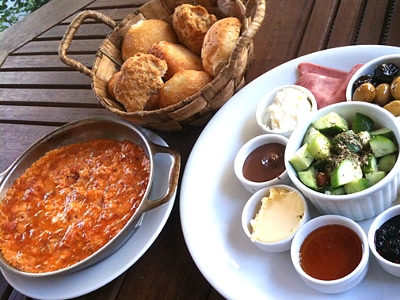
11. Simit
Think of a simit as a Turkish pretzel or bagel with sesame seeds. Simits are ubiquitous street food, available for breakfast or midday snacks for just a few lira. The dough comes in various shapes and is coated in molasses before being dipped in sesame seeds. The meaning behind simit is the Arabic word “samid,” meaning “fine flour” or “semolina.”

Additional Turkish dishes and typical ingredients
- Lokum (Turkish Delight)
- Mercimek Çorbası (lentil soup)
- Kısır (bulgur salad)
- Sarma (stuffed leaves)
- Ayran (yogurt drink)
- Pilav (rice pilaf)
- Ekmek (bread)
- Çorbas (various soups)
- Meze (appetizers)
Turkish breakfast
A standard Turkish breakfast is called “kahvaltı” and is always hearty. This normally includes:
- Fresh bread: simit or crusty white bread.
- Cheese: Feta (beyaz peynir), kasseri, or string cheese.
- Fruits and vegetables: raw olives, tomatoes, cucumbers, grapes, cherries, or melons.
- Eggs: scrambled (menemen) or boiled.
- Spreads: homemade jams, honey, or clotted cream (kaymak).
- Meats: spicy sausage (sucuk) or cured beef (pastirma).
- Turkish tea: strong black tea (çay).
- Turkish coffee: brewed in a unique pot (cezve) and served in small cups
Turkish food staples
Turkish cuisine celebrates Mediterranean, Middle Eastern, European, and Asian flavors. Turkey’s geography embodies not only its gastronomy but also its ancient history. The Ottoman Empire spanned Southeast Europe, West Asia, and North Africa from the 14th to early 20th centuries. With this comes a distinctive Anatolian style with key ingredients including:
- Olive oil: for cooking and salads.
- Yogurt: typical side dish.
- Vegetables: eggplant, zucchini, chickpeas, and green peppers are favored.
- Lamb: primary meat in traditional dishes.
- Lentils: essential for soups and stews.
- Bulgar: key ingredient for salads like tabbouleh and pilafs.
- Spices: cumin, black pepper, and paprika.
- Tomato paste: base for stews and sauces to add richness and flavor.
Turkish cuisine in major cities
Turkey’s rich culinary tradition has spread around the world thanks to expat communities.
- Berlin, Germany
The largest Turkish population outside of Turkey is Berlin, with over 250,000 people. Turkish digital nomads and expats have brought a vibrant food scene with them, and adapted Turkish cuisine; not many people realize that döner kebab was originally popularized in areas like Kreuzberg and Neukölln. - London, United Kingdom
London is home to more than 150,000 Turkish residents. Local favorites are lahmacun and köfte. Head to places like Green Lanes in Haringey, and Dalston in Hackney to enjoy Turkish food in London. - New York City, United States
Around 100,000 Turkish people live in New York City. Simit and pide are signature foods in neighborhoods like Astoria in Queens and parts of Brooklyn.
More about Turkey
Turkey has seven regions, each with distinctive cultural identities and food traditions. These regions (and their largest cities) include:
- Aegean Region (İzmir)
The region around the Aegean Sea is famous for its olive groves, vineyards, ancient ruins, stunning coastline, and joyful climate. Today, it’s a desirable destination among history buffs, retired expats, and beachgoers.- Local food: Zeytinyağlı dishes, which are vegetables cooked in olive oil.
- Black Sea Region (Samsun)
Visitors to the Black Sea Region can expect lush green landscapes and scenic coasts. Activities include hiking in the Kaçkar Mountains and visiting the Sumela Monastery.- Local food: fried, grilled, or baked hamsi (anchovies) with rice.
- Central Anatolia Region (Ankara)
With its vast plains and ancient cities, Central Anatolia attracts those interested in history and art. Main attractions include the captivating rock formations and underground cities in Cappadocia.- Local food: famous for mantı served with yogurt and garlic sauce.
- Eastern Anatolia Region (Van)
Rugged terrain and classical history characterize the Eastern Anatolia Region. Lake Van and the historic Armenian Church on Akdamar Island attract many visitors seeking scenic views.- Local food: murtuğa (a type of omelet) plus fresh cheeses, honey, and olives.
- Marmara Region (Istanbul)
The area’s attractions include iconic landmarks like the Hagia Sophia and the tranquil beauty of the Princes’ Islands. Istanbul is also a metropolitan city that attracts foreign residents and business owners from around the world. The city is also home to Türkiye İş Bankası, the national bank.- Local Food: assorted and authentic street food options like simit.
- Mediterranean Region (Antalya)
With a sunny climate and ancient ruins like Aspendos, this region is also a favorite among beachgoers and history enthusiasts.- Local Food: Heavy focus on grilled kebab meats and vegetables.
- Southeastern Region (Şanlıurfa)
This region is home to the ancient Göbekli Tepe archaeological site, spicy cuisine, and traditional music, offering a guaranteed cultural experience. Cities like Gaziantep also have distinctive Middle Eastern influences from neighboring Syria.- Local Food: spicy kebabs and vegetarian “meatballs” with bulgur and spices.
FAQs
1. What are common ingredients in Turkish cuisine?
Common ingredients in Turkish cuisine include olive oil, yogurt, lamb, eggplant, zucchini, chickpeas, green peppers, lentils, bulgur, tomato paste, and spices like cumin, black pepper, and paprika.
2. How is Turkish coffee different from other types of coffee?
Turkish coffee is finely ground, unfiltered, and brewed in a special cezve pot. Typically drunk out of small cups and often accompanied by Turkish delight.
3. What is the difference between Turkish and Greek baklava?
Although similar, Turkish baklava primarily uses pistachios, and syrup as sweetener. Meanwhile, baklava in Greece has walnuts or almonds and is sweetened with honey.
4. Are there vegetarian options in Turkish cuisine?
Some of the most well-known vegetarian options in Turkey include dolma (stuffed vegetables), mercimek çorbası (lentil soup), pide (Turkish flatbread), and various meze (appetizers).
5. What is the cultural significance of Turkish tea?
Turkish social life and hospitality revolve around tea (çay). Typically, Turkish tea is strong, black, and served throughout the day.
6. What are some popular Turkish street foods?
Popular Turkish street foods include simit (sesame-coated bread rings), döner kebab, lahmacun (Turkish pizza), gözleme (stuffed flatbread), and ice cream (dondurma). Turkish ice cream is known for its texture and playful serving style.
